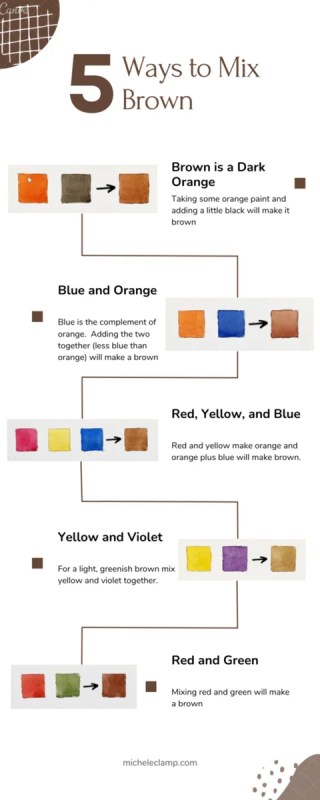For those who love painting and crafts, blending colors to create new hues is an exciting and essential part of the artistic process. One of the most popular combinations in the color palette is the creation of brown, a beautiful earthy tone that can complement a variety of art projects. Here’s a guide on how to make brown color using primary colors and simple techniques.

Credit: blog.treasurie.com
Understanding Color Theory
Before delving into the process of making brown, it’s important to understand the basics of color theory. The primary colors – red, blue, and yellow – are the building blocks of all other colors. By combining these primary colors in various proportions, an artist can produce a wide spectrum of secondary and tertiary colors, including the luscious brown we seek to create.
Mixing Brown Using Primary Colors
To produce brown, you can start with the combination of two primary colors – red and green. While it may seem counterintuitive, mixing red and green in equal parts will result in a rich, warm brown color. You can further customize the shade of brown by adjusting the proportions of red and green; for instance, more red will yield a reddish-brown, while more green will result in a cooler, earthier brown tone.
Alternative Combinations
If you don’t have green paint available, you can still create brown using other primary color combinations. Mixing red and blue together can also yield a deep purple shade, which can then be tempered with a touch of yellow to bring out the desired brown tones. Experimenting with different ratios and shades of primary colors will help you discover the perfect brown for your project.
Credit: www.quora.com
Using Complementary Colors
Another method for creating brown is by combining complementary colors. Complementary colors are those positioned directly across from each other on the color wheel. For example, yellow and purple are complementary colors, as are red and green, and blue and orange. By mixing these complementary pairs in equal proportions, you can achieve a beautiful muted brown tone.
Factors Affecting Brown Mixing
Several factors can affect the outcome of your brown mixture. The intensity of the primary colors, the quality of your paint or pigment, and the surface you are painting on can all influence the final result. It’s always best to start by mixing small amounts and testing the color on a spare surface before applying it to your artwork.
Adjusting the Tone
Once you’ve created your brown base, you can further adjust the tone by adding small amounts of complementary colors or white to lighten the shade. Experiment with different tones, shades, and tints to achieve the precise brown color you envision.
Importance of Brown in Art
Brown is an essential color in the artist’s palette, adding warmth and depth to paintings and crafts. It is commonly used to depict natural elements such as tree trunks, soil, and animal fur, as well as in creating skin tones. By mastering the art of making brown, you can enhance the realism and vibrancy of your artwork.
Frequently Asked Questions For How To Make Brown Colour?
How Do You Make Brown Color?
To make brown color, you need to mix equal parts of red, yellow, and blue paint or pigments.
Can I Create Brown Color By Mixing Other Colors?
Yes, brown color can be created by mixing different combinations of primary colors such as red, yellow, and blue.
What Colors Should I Mix To Create A Dark Brown Color?
To create a dark brown color, you can mix more red and blue pigments with a touch of yellow.
How Can I Make A Lighter Shade Of Brown?
To make a lighter shade of brown, gradually add more yellow or white paint to your mixture until the desired shade is achieved.
Conclusion
In conclusion, creating brown is a simple yet crucial skill for any artist or crafter. By understanding color theory and experimenting with primary and complementary color combinations, you can achieve a wide range of beautiful brown tones. These skills are invaluable for producing realistic and visually appealing artwork, and can open up a world of creative possibilities. So go ahead, grab your paint and brushes, and start blending – your perfect shade of brown awaits!

